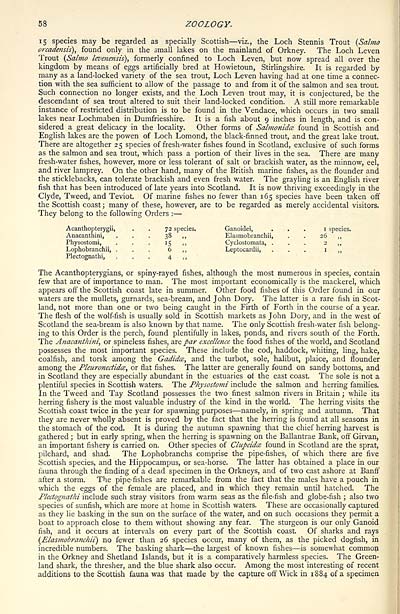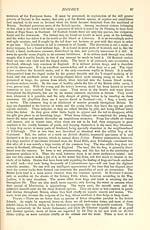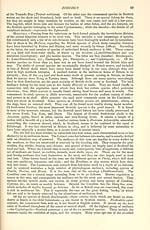Ordnance gazetteer of Scotland > Volume 6
(386) Page 58
Download files
Complete book:
Individual page:
Thumbnail gallery: Grid view | List view

58 ZOOLOGY.
15 species may be regarded as specially Scottish — viz., the Loch Stennis Trout (Salmo
orcadensis), found only in the small lakes on the mainland of Orkney. The Loch Leven
Trout {Salmo leve?iensis), formerly confined to Loch Leven, but now spread all over the
kingdom by means of eggs artificially bred at Howietoun, Stirlingshire. It is regarded by
many as a land-locked variety of the sea trout, Loch Leven having had at one time a connec-
tion with the sea sufficient to allow of the passage to and from it of the salmon and sea trout.
Such connection no longer exists, and the Loch Leven trout may, it is conjectured, be the
descendant of sea trout altered to suit their land-locked condition. A still more remarkable
instance of restricted distribution is to be found in the Vendace, which occurs in two small
lakes near Lochmaben in Dumfriesshire. It is a fish about 9 inches in length, and is con-
sidered a great delicacy in the locality. Other forms of Salmonida found in Scottish and
English lakes are the powen of Loch Lomond, the black-finned trout, and the great lake trout.
There are altogether 25 species of fresh-water fishes found in Scotland, exclusive of such forms
as the salmon and sea trout, which pass a portion of their lives in the sea. There are many
fresh-water fishes, however, more or less tolerant of salt or brackish water, as the minnow, eel,
and river lamprey. On the other hand, many of the British marine fishes, as the flounder and
the sticklebacks, can tolerate brackish and even fresh water. The grayling is an English river
fish that has been introduced of late years into Scotland. It is now thriving exceedingly in the
Clyde, Tweed, and Teviot. Of marine fishes no fewer than 165 species have been taken off
the Scottish coast ; many of these, however, are to be regarded as merely accidental visitors.
They belong to the following Orders : —
Acanthopterygii,
Anacanthini,
72 species.
38 „
Ganoidei,
Elasmobranchii,
1 species
26 „
Physostomi,
Lophobranchii, .
Plectognathi,
15 »
6 „
4 „
Cyclostomata, .
Leptocardii,
2
1 '.,
The Acanthopterygians, or spiny-rayed fishes, although the most numerous in species, contain
few that are of importance to man. The most important economically is the mackerel, which
appears off the Scottish coast late in summer. Other food fishes of this Order found in our
waters are the mullets, gurnards, sea-bream, and John Dory. The latter is a rare fish in Scot-
land, not more than one or two being caught in the Firth of Forth in the course of a year.
The flesh of the wolf-fish is usually sold in Scottish markets as John Dory, and in the west of
Scotland the sea-bream is also known by that name. The only Scottish fresh-water fish belong-
ing to this Order is the perch, found plentifully in lakes, ponds, and rivers south of the Forth.
The Anacanthini, or spineless fishes, axe par excellence the food fishes of the world, and Scotland
possesses the most important species. These include the cod, haddock, whiting, ling, hake,
coalfish, and torsk among the Gadidce, and the turbot, sole, halibut, plaice, and flounder
among the Plenrotiedidee, or flat fishes. The latter are generally found on sandy bottoms, and
in Scotland they are especially abundant in the estuaries of the east coast. The sole is not a
plentiful species in Scottish waters. The Physostomi include the salmon and herring families.
In the Tweed and Tay Scotland possesses the two finest salmon rivers in Britain ; while its
herring fishery is the most valuable industry of the kind in the world. The herring visits the
Scottish coast twice in the year for spawning purposes — namely, in spring and autumn. That
they are never wholly absent is proved by the fact that the herring is found at all seasons in
the stomach of the cod. It is during the autumn spawning that the chief herring harvest is
gathered ; but in early spring, when the herring is spawning on the Ballantrae Bank, off Girvan,
an important fishery is carried on. Other species of Clupeidce found in Scotland are the sprat,
pilchard, and shad. The Lophobranchs comprise the pipe-fishes, of which there are five
Scottish species, and the Hippocampus, or sea-horse. The latter has obtained a place in our
fauna through the finding of a dead specimen in the Orkneys, and of two cast ashore at Banff
after a storm. The pipe-fishes are remarkable from the fact that the males have a pouch in
which the eggs of the female are placed, and in which they remain until hatched. The
Plectognathi include such stray visitors from warm seas as the file-fish and globe-fish ; also two
species of sunfish, which are more at home in Scottish waters. These are occasionally captured
as they lie basking in the sun on the surface of the water, and on such occasions they permit a
boat to approach close to them without showing any fear. The sturgeon is our only Ganoid
fish, and it occurs at intervals on every part of the Scottish coast. Of sharks and rays
{Elasjnobranchii) no fewer than 26 species occur, many of them, as the picked dogfish, in
incredible numbers. The basking shark — the largest of known fishes — is somewhat common
in the Orkney and Shetland Islands, but it is a comparatively harmless species. The Green-
land shark, the thresher, and the blue shark also occur. Among the most interesting of recent
additions to the Scottish fauna was that made by the capture off Wick in 1 884 of a specimen
15 species may be regarded as specially Scottish — viz., the Loch Stennis Trout (Salmo
orcadensis), found only in the small lakes on the mainland of Orkney. The Loch Leven
Trout {Salmo leve?iensis), formerly confined to Loch Leven, but now spread all over the
kingdom by means of eggs artificially bred at Howietoun, Stirlingshire. It is regarded by
many as a land-locked variety of the sea trout, Loch Leven having had at one time a connec-
tion with the sea sufficient to allow of the passage to and from it of the salmon and sea trout.
Such connection no longer exists, and the Loch Leven trout may, it is conjectured, be the
descendant of sea trout altered to suit their land-locked condition. A still more remarkable
instance of restricted distribution is to be found in the Vendace, which occurs in two small
lakes near Lochmaben in Dumfriesshire. It is a fish about 9 inches in length, and is con-
sidered a great delicacy in the locality. Other forms of Salmonida found in Scottish and
English lakes are the powen of Loch Lomond, the black-finned trout, and the great lake trout.
There are altogether 25 species of fresh-water fishes found in Scotland, exclusive of such forms
as the salmon and sea trout, which pass a portion of their lives in the sea. There are many
fresh-water fishes, however, more or less tolerant of salt or brackish water, as the minnow, eel,
and river lamprey. On the other hand, many of the British marine fishes, as the flounder and
the sticklebacks, can tolerate brackish and even fresh water. The grayling is an English river
fish that has been introduced of late years into Scotland. It is now thriving exceedingly in the
Clyde, Tweed, and Teviot. Of marine fishes no fewer than 165 species have been taken off
the Scottish coast ; many of these, however, are to be regarded as merely accidental visitors.
They belong to the following Orders : —
Acanthopterygii,
Anacanthini,
72 species.
38 „
Ganoidei,
Elasmobranchii,
1 species
26 „
Physostomi,
Lophobranchii, .
Plectognathi,
15 »
6 „
4 „
Cyclostomata, .
Leptocardii,
2
1 '.,
The Acanthopterygians, or spiny-rayed fishes, although the most numerous in species, contain
few that are of importance to man. The most important economically is the mackerel, which
appears off the Scottish coast late in summer. Other food fishes of this Order found in our
waters are the mullets, gurnards, sea-bream, and John Dory. The latter is a rare fish in Scot-
land, not more than one or two being caught in the Firth of Forth in the course of a year.
The flesh of the wolf-fish is usually sold in Scottish markets as John Dory, and in the west of
Scotland the sea-bream is also known by that name. The only Scottish fresh-water fish belong-
ing to this Order is the perch, found plentifully in lakes, ponds, and rivers south of the Forth.
The Anacanthini, or spineless fishes, axe par excellence the food fishes of the world, and Scotland
possesses the most important species. These include the cod, haddock, whiting, ling, hake,
coalfish, and torsk among the Gadidce, and the turbot, sole, halibut, plaice, and flounder
among the Plenrotiedidee, or flat fishes. The latter are generally found on sandy bottoms, and
in Scotland they are especially abundant in the estuaries of the east coast. The sole is not a
plentiful species in Scottish waters. The Physostomi include the salmon and herring families.
In the Tweed and Tay Scotland possesses the two finest salmon rivers in Britain ; while its
herring fishery is the most valuable industry of the kind in the world. The herring visits the
Scottish coast twice in the year for spawning purposes — namely, in spring and autumn. That
they are never wholly absent is proved by the fact that the herring is found at all seasons in
the stomach of the cod. It is during the autumn spawning that the chief herring harvest is
gathered ; but in early spring, when the herring is spawning on the Ballantrae Bank, off Girvan,
an important fishery is carried on. Other species of Clupeidce found in Scotland are the sprat,
pilchard, and shad. The Lophobranchs comprise the pipe-fishes, of which there are five
Scottish species, and the Hippocampus, or sea-horse. The latter has obtained a place in our
fauna through the finding of a dead specimen in the Orkneys, and of two cast ashore at Banff
after a storm. The pipe-fishes are remarkable from the fact that the males have a pouch in
which the eggs of the female are placed, and in which they remain until hatched. The
Plectognathi include such stray visitors from warm seas as the file-fish and globe-fish ; also two
species of sunfish, which are more at home in Scottish waters. These are occasionally captured
as they lie basking in the sun on the surface of the water, and on such occasions they permit a
boat to approach close to them without showing any fear. The sturgeon is our only Ganoid
fish, and it occurs at intervals on every part of the Scottish coast. Of sharks and rays
{Elasjnobranchii) no fewer than 26 species occur, many of them, as the picked dogfish, in
incredible numbers. The basking shark — the largest of known fishes — is somewhat common
in the Orkney and Shetland Islands, but it is a comparatively harmless species. The Green-
land shark, the thresher, and the blue shark also occur. Among the most interesting of recent
additions to the Scottish fauna was that made by the capture off Wick in 1 884 of a specimen
Set display mode to: Large image | Transcription
Images and transcriptions on this page, including medium image downloads, may be used under the Creative Commons Attribution 4.0 International Licence unless otherwise stated. ![]()
| Gazetteers of Scotland, 1803-1901 > Ordnance gazetteer of Scotland > Volume 6 > (386) Page 58 |
|---|
| Permanent URL | https://digital.nls.uk/97392234 |
|---|
| Attribution and copyright: |
|
|---|---|

